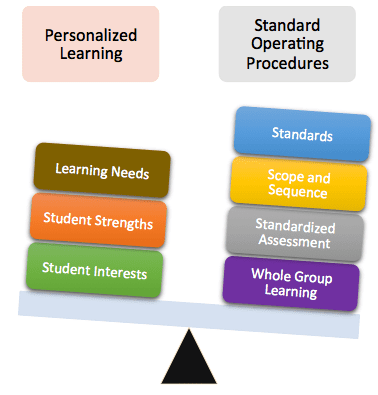Tips for the 21st Century classroom
By Welda Simousek
 If personalized learning is the direction in which we want to move, how do we “tip the scale” in favor of it, to help us as educators to facilitate the academic success of each student through their learning needs, strengths, and interests? After all, whole group learning, standards, the scope and sequence, and, especially, the standardized assessment we typically use and teach to tend to drive our curriculum.
If personalized learning is the direction in which we want to move, how do we “tip the scale” in favor of it, to help us as educators to facilitate the academic success of each student through their learning needs, strengths, and interests? After all, whole group learning, standards, the scope and sequence, and, especially, the standardized assessment we typically use and teach to tend to drive our curriculum.
In personalized learning settings, teachers assess students’ strengths, needs, and interests to better align their teaching with each student’s learning profile while maintaining high standards. This can be accomplished through a variety of methods:
- Flexible student grouping: Groupings that are flexible and dynamic, responding to ever-changing student needs based on continuously collected (formative) data.
- Learning spaces that support personalized learning: Just as groupings are flexible and dynamic, the learning space must accommodate changes based on the groupings needed and individual student learning needs at the time.
- Involve students in discussing data: Students need to be aware of their own learning goals and the progress they are making.
 It sounds simple enough, but how do we, as educators, go about setting the stage for all of this to happen? Some of the answers rely on technology, but even without a great deal of technology at educators’ fingertips, it is possible to deliver personalized learning. Here are some tips from many people who manage this on a daily basis:
It sounds simple enough, but how do we, as educators, go about setting the stage for all of this to happen? Some of the answers rely on technology, but even without a great deal of technology at educators’ fingertips, it is possible to deliver personalized learning. Here are some tips from many people who manage this on a daily basis:
• Learn about your students’ needs, strengths, and interests: This can be done in a variety of ways, but the important part is that it is not static information. This information must be continually re-gathered throughout the year, as students’ strengths, needs, and interests change and grow.
• Student learning needs can be continually assessed (starting with pretesting students’ knowledge before each unit) through quick written quizzes (which can be self-graded so students get immediate feedback on their proficiency levels), simple “thumbs-up, thumbs-down” techniques, exit slips, or through computer software programs that give students practice questions and quickly diagnose trouble spots, or clickers (remote-response systems that allow teachers to see which student got it right or wrong), etc.
• Student strengths can be assessed periodically by something as simple as asking students, on a continuum, what they believe their ability is in a certain area (see the Novice to Expert explanation* at the end of this article), or by giving students different short tasks to perform in a variety of modes and styles to see where their strengths lie.
• Student interests can be discovered through letting students tell you this through a short inventory**, through one-on-one conferencing with students, or by simply laying out choices for students and letting them pick their pathway.
• Once you have all of this information, you need to have a method for managing all of it. Personalized Learning Platforms (PLPs) are springing up on the market or being developed by school systems for their own needs. Your school may already have a learning management system in place that will allow you to keep track of all of this data. If all else fails, you can create your own spreadsheet of data that you can continually update.
 Automate what you can, and allow students to make choices whenever possible: Utilize educational computer programs to do much of the basic-skills practice and assessment so this does not eat up too much of your or your students’ time. Then, whenever possible, instead of you making all of the decisions, allow your students to make choices (remember, they need to have access to their own data on progress to help them do this).
Automate what you can, and allow students to make choices whenever possible: Utilize educational computer programs to do much of the basic-skills practice and assessment so this does not eat up too much of your or your students’ time. Then, whenever possible, instead of you making all of the decisions, allow your students to make choices (remember, they need to have access to their own data on progress to help them do this).
This also means you need to provide students with multiple options for demonstrating their learning, keeping in mind different learning styles as you do so. Student choice is a powerful tool to help students be engaged in whatever tasks they pursue. Allowing students to conduct part of the instruction is also a powerful opportunity to let them demonstrate their strengths and interests, as well as saving you time and energy.
• Practice all the grouping options, how to “get there,” and how to conduct oneself as a learner: Students don’t automatically know how to do individual, small group, or whole group learning unless they are given some guidance. Be sure to create some simple rules for each ahead of time, and then practice moving between the different groups several times so that students can do it quickly and efficiently.
Sitting with your students and developing a “T-chart” for behavior expectations in each setting will go a long way to making things work smoothly. You might have an expectation of “working quietly” for example, and in your head, that looks one way, but in your students’ heads it may look entirely differently. So, write up a T-chart with one side stating, “looks like” and the other side stating, “sounds like” and have your students suggest what it looks like and sounds like to “work quietly.” Now, you’re all on the same page.
T-Chart for “Working Quietly”
| LOOKS LIKE | SOUNDS LIKE |
| Heads of students down or close together | Hearing no sounds or “6-inch” voices |
| Work materials laid out in front of students | On task discussion, if any |
| No students moving around the room |
• Learn your new role as a “facilitator of learning:” In the personalized learning world, the teacher is no longer the deliverer of the content, while the students sit passively taking in the content (supposedly). You may need to learn new skills in order to facilitate the learning of your students, including perhaps learning to “flip” your classroom so that the lecture you might have given in class is delivered via video streaming to your students to watch at home, giving you more class time to concentrate on supporting your students in applying the essential and enduring concepts.
• Help your students become better self-assessors and data collectors/interpreters: Just as you no longer want to be the bearer of all the information in terms of learning, you don’t want to have to do all of the assessment of learning. The more your students learn to self-assess and analyze the data from this self-assessment, the better learners they will be.
In the book, How to Get to the Heart of Differentiation, Real Time Assessments, 2nd Edition,*** you can find many different ways to have students self-assess, many of which only take a few moments of time. The Novice to Expert technique mentioned earlier is one. Another excellent one is the Stoplight Method where you draw a large stoplight on a piece of chart paper, and as the students leave the room, they place a post-it note on one of the three colors:
- RED: What is “stopping” or “interfering” with their learning? What are they very confused about?
- YELLOW: What do they have questions about, or what are they unsure about?
- GREEN: What do they know for sure? What is some “securely held content” for them?
 If all or most of the above is put into place and practiced in classrooms, the balance can indeed be tipped in favor of personalized learning. This would mean students are likely to learn more content, learn more about themselves, and take more control of their own learning. What a wonderful scenario for our 21st Century classrooms!
If all or most of the above is put into place and practiced in classrooms, the balance can indeed be tipped in favor of personalized learning. This would mean students are likely to learn more content, learn more about themselves, and take more control of their own learning. What a wonderful scenario for our 21st Century classrooms!
* Novice to Expert line: This is an imaginary line (or one made with tape) that goes from one to ten, one being the “novice” or beginner end and ten being the “expert” end. Explain to students that it’s okay to be a novice in something, as long as they work on getting better; it takes 10,000 hours of practice to become an expert. Each student should stand on the line where they think they are in their understanding of a certain concept (do this with about five students at a time). Have each student explain why they’re standing where they are. You should first practice this with a simple question like “How well do I clean my room?” and then go on to the real concept you want to know about.
**How to Get to the Heart of Differentiation, Book 2, Student Strengths/ Interests, by Welda Simousek and Virginia Pickerell contains several sample student inventories. It can be purchased at https://weldaconsults.com.
***How to Get to the Heart of Differentiation, Real Time Assessments, 2nd Edition by Welda Simousek and Virginia Pickerell contains the Novice to Expert line example and Stoplight example, as well as many other simple formative assessments. It can be purchased on Amazon or at https://weldaconsults.com
Author
 Welda Simousek is the author of several books (mentioned above), an experienced educational consultant, and owner of Welda Consults, LLC, which is a customized professional development company, https://weldaconsults.com.
Welda Simousek is the author of several books (mentioned above), an experienced educational consultant, and owner of Welda Consults, LLC, which is a customized professional development company, https://weldaconsults.com.
Further Reading
- eSchool News – 4 reasons data is crucial for personalized learning
- EdSurge – Where Does Personalized Learning End and Special Education Begin?
- NPR – How ‘personalized learning’ can put college in reach for nontraditional students
